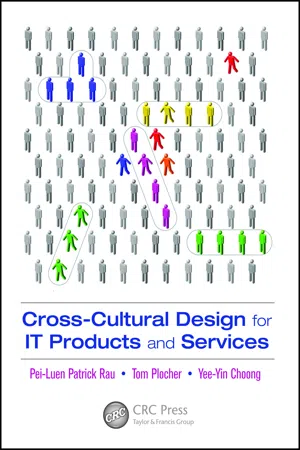Technology & Engineering
Anthropometry
Anthropometry is the study of the measurement of the human body. It involves collecting data on body dimensions, such as height, weight, and proportions, to understand variations in human size and shape. This information is used in various fields, including product design, ergonomics, and architecture, to create products and environments that are better suited to the human body.
Written by Perlego with AI-assistance
Related key terms
1 of 5
12 Key excerpts on "Anthropometry"
- eBook - PDF
- John R. Wilson, Sarah Sharples, John R. Wilson, Sarah Sharples(Authors)
- 2015(Publication Date)
- CRC Press(Publisher)
725 27 Anthropometry for Ergonomic Design David Feathers, Clive D’Souza and Victor Paquet INTRODUCTION Anthropometry is the study of human body sizes and abilities. Anthropometry is derived from the Greek words ‘anthropo’, meaning ‘human being’, and ‘metry’, meaning ‘measure’. Anthropometry provides descriptive information about the distributional characteristics of physical body dimen-sions and functional abilities of large samples of people. Physical anthropometric dimensions include basic whole-body measurements such as standing height, as well as specific body segment lengths, widths, depths, circumferences and weights. Functional abilities include things such as grip strength, push and pull strength, reaching capabilities, fields of vision and applied measurements specific to task performance. Anthropometry has been applied as early as when ancient Greek and Egyptian artists used physical body measurements to make representations of people more realistic. Today, anthro-pometry is used in many disciplines. Physical anthropologists use Anthropometry to investigate CONTENTS Introduction .................................................................................................................................... 725 Anthropometric Measurement Methods ........................................................................................ 726 Body Measurements ....................................................................................................................... 726 Functional Anthropometric Measurements .................................................................................... 731 Evaluation of Measurement Error .................................................................................................. 733 Applying Anthropometric Data in Ergonomic Design .................................................................. - Pei-Luen Rau, Tom Plocher, Yee-Yin Choong(Authors)
- 2012(Publication Date)
- CRC Press(Publisher)
131 9 Physical Ergonomics and Anthropometry 9.1 INTRODUCTION TO THE PROBLEM 9.1.1 A NTHROPOMETRY The study of body sizes and other associated characteristics is generally referred to as Anthropometry (Lehto and Buck, 2008). Anthropometry involves the measure-ments of body size, shape, strength, mobility and flexibility, and working capacity (Pheasant and Haslegrave, 2006). Anthropometric measurements are essential when designing devices, equipment, and systems for users. Humans vary in body dimensions, shapes, and other char-acteristics, thus ergonomic design requires an understanding of the variability of human beings. Depending on the database consulted, the measurements included may range from simply stature and weight, to thousands of measurements, including multiple postures and detailed facial measurements. Anthropometric data can be classified by the sample of the subjects: military sol-diers or civilians. The anthropometric information about the military soldiers has a long history and is rather complete (Kroemer, Kroemer, and Kroemer-Elbert, 1990). The military has always had a particular interest in the body dimensions of sol-diers in order to provide proper fitting of uniforms, armor, and other equipment. The recently published Human Integration Design Handbook (HIDH), NASA/SP-2010-3407 (NASA, 2010) provides a good overview of the Anthropometry as well as pro-vides guidance for human factors design especially for human space flight programs and projects. However, military data should be used with caution when applied to a civilian population because of the selection biases of the young and healthy sample. In the past ten years, many institutes, libraries, and commercial companies across the world conducted large surveys of anthropometric data of the civilians in different nationalities. The anthropometric data of civilians from different nationalities can be used for designing products for people from different nationalities.- eBook - PDF
Occupational Ergonomics
Theory and Applications, Second Edition
- Amit Bhattacharya, James D. McGlothlin(Authors)
- 2012(Publication Date)
- CRC Press(Publisher)
Often the problem with the application of anthropom-etry to a design problem will be the lack of certain necessary measurements or the need to accommodate a wide range in size and shape variability into a single, often inflexible design. Applied Anthropometry—that is, the use of anthropometric data in the design and construction of a wide variety of items from clothing to spacecraft—is a relatively new discipline whose practitioners are still learning to cope with the exponential character of technology and its impact on the kinds of information needed to describe the physical and biological characteristics of our species. It grew out of physical anthropology, which traditionally studied body size and function with the goal of resolving our ancestry and identifying the existing varieties of Homo sapiens . Today, we are still trying to learn what to measure to satisfy an even younger discipline called ergonomics. The original impetus for the development of applied anthropometries, and perhaps ulti-mately ergonomics, was the need to improve the effectiveness and efficiency of equipment used in combat during World War II. The military tie was so strong in the United States that it has been recognized only relatively recently that civilian industry could also benefit from the proper use of Anthropometry in the design of products and workstations. Today industry has embraced the concept so eagerly that the word ergonomics , which derives from the Greek ergon (work) and nomos (natural laws of), has become popularly used in advertisements. A concern for ergonomics currently spawns industrial action commit-tees, comprising members of both management and labor, whose purpose is to improve the human–machine interface to achieve a healthier, safer, and more efficient workforce. Anthropometric data are a necessary and basic tool for attaining this end as well as improv-ing the design of a wide variety of products. - eBook - PDF
- Nico J. Delleman, Christine M. Haslegrave, Don B. Chaffin(Authors)
- 2004(Publication Date)
- CRC Press(Publisher)
43 Summary ....................................................................................................... 44 References ............................................................................................................... 45 Introduction Anthropometry is the study of the physical, dimensional measurement of humans. Although it has a long history as a subdiscipline of physical anthro-pology, its use as an applied science is more recent and dates to the mid-20th century (e.g., Dempster 1955). Currently, a distinction is made between applied Anthropometry (sometimes called engineering Anthropometry) and the more academic Anthropometry that is used in research in conjunction with other areas of human biology (Meredith 1953, Jensen and Nassas 1988, NCHS 1996). In this chapter, a further distinction is made within applied Anthropometry, based on the techniques used to gather the raw data. In the first section, the focus is on anthropometric data collected using traditional techniques and 18 Working Postures and Movements: Tools for Evaluation and Engineering using traditional instruments, such as the anthropometer, calipers, and measuring tape. Traditional anthropometric instruments provide measure-ments of the body or its parts in one dimension, such as the length of the forearm. They can also provide measurements of a two-dimensional body feature along a plane, such as in head circumference. The second section is devoted to the use of various three-dimensional systems, which can be used to generate surface representations of the body shape. They can also provide measures of surface area or volume, which are generally difficult to obtain with traditional instruments. 2.1 Traditional Anthropometry Bruce Bradtmiller, Claire C. Gordon, Makiko Kouchi, Hans W. Jürgens, and Young-Suk Lee Introduction In applied Anthropometry, the dimensions are used for various design tasks. - eBook - PDF
- Vivek D. Bhise(Author)
- 2016(Publication Date)
- CRC Press(Publisher)
13 2 Engineering Anthropometry and Biomechanics INTRODUCTION The process of vehicle design begins with a discussion on the size and type of the vehicle and the number of occupants that the vehicle should accommodate. To assure that the required number of occupants can be accommodated, the designers must consider the dimensions of drivers and the passengers and their posture in the vehicle space. Therefore, in this chapter, we will review basic concepts, principles, and data related to human anthropometric and biomechanical characteristics, along with the considerations used in vehicle design, with an emphasis on occupant package and seating design. Anthropometry and biomechanics are related fields in the sense that both depend on the dimen-sions of humans and the ability of humans to assume different postures while working or using vehicles. The two fields can be defined as follows. Engineering Anthropometry is the science of measurement of human body dimensions of differ-ent populations. It deals with skeletal dimensions (which are measured from certain reference points on the bones that are less flexible as compared with skin tissues), shape, contours, area, volumes, centers of gravity, weights, and so forth, of the entire human body and body segments. Engineering Anthropometry involves applications of the anthropometric measurement data to design and evalu-ate products to accommodate people. Biomechanics deals primarily with dimensions, composition, and mass properties of body segments, joints linking the body segments, muscles that produce body movements, mobility of joints, mechanical reactions of the body to force fields (e.g., static and dynamic force applications, vibrations, impacts), and voluntary body movements in applying forces (torques, energy/power) to external objects (e.g., controls, tools, handles). - eBook - PDF
Human Factors Engineering and Ergonomics
A Systems Approach, Second Edition
- Stephen J. Guastello(Author)
- 2013(Publication Date)
- CRC Press(Publisher)
171 8 Anthropometry and Workspace Design Anthropometry is the study of all measurements of the human body and the uses of this information. It naturally progresses to workspace design and some related issues in bio-mechanics. This chapter extends the basic ideas of human measurement to physical abili-ties such as strength and balance. Body Measurements The study of bodily measurements began with some of the earliest uses of descriptive statistics by Adolph Quetelet (1976–1874; Howell, 1992). Importantly, Quetelet discovered that the measurements were normally distributed. Although the prevalence of the normal distribution in biological and psychological measurement can easily be taken for granted, the finding gives statisticians a great deal of direction for handling and interpreting large populations of measurements and samples taken from theoretical populations. Figure 8.1 shows several aspects of bodily measurements that are used for common workspace design problems: operator standing, operator’s reach envelope on a flat work-bench, and operator’s seated area. The arrows mark commonly needed measurements. For the most part, workspace engineers can rely on tables compiled in known documents such as U.S. Army (1979) and Roebuck (1995) for U.S. military and civilian populations, Pheasant (1996) and Pheasant and Haslegrave (2005) for British populations of varying ages, and PeopleSize (Open Ergonomics, 2000) for a compendium of international samples. In addition to the linear measurements denoted in Figure 8.1, circumference measure-ments such as the wrist and forearm, are also included in some tabular sources. Some occupational groups could differ from the general population as a result of the people who are attracted to the job and how they are selected. Electric utility workers, for example, tend to run larger than the average population (Marklin, Saginus, Seeley, & Freier, 2010). - William S. Marras, Waldemar Karwowski(Authors)
- 2006(Publication Date)
- CRC Press(Publisher)
The following text describes the steps involved, provides statistical tools, and supplies anthropometric data. 9.2 Terminology While all humans have heads and trunks, arms and legs, the body parts come in various sizes, assembled in different proportions. Anthropometry is the name of the science of measuring human bodies. Table 9.1 lists special terms often used in Anthropometry. Together with the reference planes shown in Figure 9.1, they describe major aspects of anthropometric information useful to designers and engineers. 9 -1 9.3 Designing to Fit the Body A few common statistic terms can describe the results of anthropometric surveys because body data usually appear, statistically speaking, in a normal (Gaussian) distribution. If the sample size is large enough, the statistical descriptors mean (same as average ), standard deviation , and range completely define a normal distribution of data (see below for more detail). Misunderstanding and misuse has led to the false idea that one could “design for the average”; yet, the mean value is larger than half the data, and smaller than the other half. Consequently, the “average” does not describe the ranges of different statures, arm lengths, or hip breadths. Furthermore, one is unlikely ever to encounter a person who displays mean values in several, many, or all dimensions. The mythical “average person” is nothing but a statistical phantom. S TEPS IN D ESIGN THAT F IT C LOTHING , T OOLS , W ORKSTATIONS, AND E QUIPMENT TO THE B ODY ( Adapted from Kroemer et al., 1997, 2001 ) Step 1 : Select those anthropometric measures that directly relate to defined design dimensions. Examples are: hand length related to handle size; shoulder and hip breadth related to escape-hatch diameter; head length and breadth related to helmet size; eye height related to the heights of windows and displays; knee height and hip breadth related to the leg room in a console.- eBook - PDF
- Shrawan Kumar(Author)
- 2007(Publication Date)
- CRC Press(Publisher)
Both are essential components of ergonomics . In August 2000, the Council of 41 the International Ergonomics Association (IEA) de fi ned ergonomics (aka human factors or human engineering) as . Scienti fi c discipline concerned with the understanding of interactions among humans and other elements of a system and . Profession that applies theory, principles, data, and methods to design in order to optimize human well-being and overall system performance The ergonomic goal is to design tasks, jobs, products, environments, and systems so that they are compatible with the needs, abilities, and limitations of people. 2.1.1 Anthropometry Procedures to measure the human body followed throughout the twentieth century the techniques that Martin [1] developed in 1914 [2 – 4]. The 1978 NASA = Webb sourcebook [5] contains an exhaustive collection of anthropometric data available during the mid-1970s. Since then, numerous publications describing national, ethnic, professional, age-related, and other groupings have appeared in the literature (see, for example, Kroemer's [6] compilation of anthropometric information). In the 1990s, new three-dimensional (3D) computerized procedures to measure and describe the surface topography of the human body became practical. Currently, these new procedures augment the classic manual measurement techniques; they may eventually replace the classic techniques, however. Several publications provide information on old and emerging anthropometric techniques [7 – 20]. US and French clothing industry groups recently recorded the surface geometry of thousands of adults in their home countries [21 – 24]. The French have published some of the results; yet, most of the data will not be publicly available for several years. The American data are available by payment; contact SizeUSA[TC] 2 at [email protected]. - eBook - PDF
- Gavriel Salvendy, Waldemar Karwowski, Gavriel Salvendy, Waldemar Karwowski(Authors)
- 2021(Publication Date)
- Wiley(Publisher)
PART 3 DESIGN OF EQUIPMENT, TASKS, JOBS, AND ENVIRONMENTS CHAPTER 11 THREE-DIMENSIONAL (3D) Anthropometry AND ITS APPLICATIONS IN PRODUCT DESIGN Liang Ma Tsinghua University Beijing, China Jianwei Niu University of Science and Technology Beijing Beijing, China 1 INTRODUCTION 283 2 HISTORICAL EVOLUTION OF Anthropometry MEASUREMENTS 284 3 DATA AQUISITION 285 3.1 3D Anthropometry Measurement Procedure 285 3.2 Errors in 3D Data Acquisition and Countermeasures 286 3.3 Noise 286 3.4 Missing Data 287 3.5 Countermeasures in Data Acquisition 287 4 DATA PROCESSING 287 4.1 Data Quality Requirement for 3D Anthropometry 287 4.2 Key Steps in the Data Processing 288 4.3 Point Cloud Registration 289 4.4 Landmark Identification 289 5 APPLICATION IN PRODUCT DESIGN 292 5.1 General Approach 292 5.2 3D Anthropometry for Dynamic Application 293 5.3 Target Population 294 5.4 Product-Oriented Application 294 6 FUTURE TRENDS IN 3D Anthropometry AND PRODUCT DESIGN 297 6.1 Individualized Product Design 297 6.2 Mass Customization Using 3D Anthropometry Data 297 6.3 Human–Machine Interface Design 298 6.4 Portable 3D Scanner 298 7 CONCLUSION 299 REFERENCES 299 1 INTRODUCTION Anthropometry is the study of measurement of the human body (Easterby, Kroemer, & Chaffin, 1980; Jones & Rioux, 1997; Robinette & Hudson, 2006), which deals with the measurement of size, mass, shape, and inertial properties of the human body (Chaffin, Andersson, & Martin, 2006). In this chapter, our dis-cussion is limited to the measurement of geometrical features of human body. The human body is considered a complex system that varies by individuals in size and shape. Therefore, obtain-ing accurate human body data is essential for product design. Those data are obtained by measuring dimensions between body surface landmarks with simple instruments in conventional approaches. - eBook - PDF
Occupational Ergonomics
Principles of Work Design
- Waldemar Karwowski, William S. Marras, Waldemar Karwowski, William S. Marras(Authors)
- 2003(Publication Date)
- CRC Press(Publisher)
For more detail see Kroemer, Kroemer, and Kroemer-Elbert (1997). 9.2 Terminology Special terms often used in Anthropometry are listed in Table 9.1. Together with the reference planes shown in Figure 9.1, they describe major aspects of anthropometric information used by designers and engineers. 9.3 Designing to Fit the Body While all humans have heads and trunks, arms and legs, the body parts come in various sizes and are assembled in different proportions. The science of measuring human bodies is called Anthropometry. The results of anthropometric surveys are described in statistical terms. Karl H. E. Kroemer Virginia Tech 9 -2 Occupational Ergonomics: Principles of Work Design Most body data appear, statistically speaking, in a normal (Gaussian) distribution. Such distribution of data can be described by using the statistical descriptors mean (same as average ), standard deviation, and range , if the sample size is large enough (see below for more detail). Misunderstanding and misuse have led to the false idea that one could “design for the average”; yet, the mean value is larger than half the data, and smaller than the other half. Consequently, the “average” does not describe the ranges of different statures, arm lengths, or hip breadths. Furthermore, one is unlikely ever to encounter a person who displays mean values in several, many, or all dimensions. The mythical “average person” is nothing but a statistical phantom. “A pioneer in the field of statistics, Sir Francis Galton (1822–1911) wrote years ago that ‘it is difficult to understand why statisticians commonly limit their interests to averages. - Matthew Bret Weinger, Michael E. Wiklund, Daryle Jean Gardner-Bonneau, Matthew Bret Weinger, Michael E. Wiklund, Daryle Jean Gardner-Bonneau(Authors)
- 2010(Publication Date)
- CRC Press(Publisher)
Biomechanics is the use of laws of physics and engineering principles to study various body segments as they move and are acted on by internal and external forces. Most of the anthropometric and biomechanical information available today is not spe-cific to health care professionals and patients or to medical equipment. However, much of the published body size data are just as useful to the medical device designer as they are to any other designer who must combine human physical dimensions with workplace tasks and equipment. Human biomechanical principles apply to the design process of a device as well. Therefore, this chapter contains many data tables, figures, and other resources that will facilitate the application of anthropometric and biomechanical data to the design of medical devices. This chapter presents a broad assortment of anthropometric data because of the inherent, wide range of human physical dimensions that exists in any population. This is particularly an issue in ethnically diverse workplaces, as individuals may differ drastically in their physical characteristics. In the United States, variability in the physical sizes of workers is expected to increase in the future. The U.S. Bureau of Labor Statistics projects that, in the upcoming decade, the percentage of newly hired African American, Hispanic, and Asian employees will far exceed new Caucasian workers. This affects the design of medical devices because these groups can differ in many physical dimensions. The resulting vari-ability in size, strength, and mobility among device users requires that anthropometric and biomechanical factors be taken into account to ensure the proper design of medical devices, accessories, and work environments. This chapter includes data on body size distributions of males and females. This is important, as there are many medical devices for which knowledge of user anthropomet-rics is critical to design.- eBook - PDF
Ergonomics for All: Celebrating PPCOE's 20 years of Excellence
Selected Papers of the Pan-Pacific Conference on Ergonomics, 7-10 November 2010, Kaohsiung, Taiwan
- Dyi-Yih Michael Lin, Hsieh-Ching Chen(Authors)
- 2010(Publication Date)
- CRC Press(Publisher)
Part I: Anthropometry, biomechanics & physical ergonomics 3 Ergonomics for All: Celebrating PPCOE’s 20 years of excellence – Lin & Chen (eds) © 2011 Taylor & Francis Group, London, ISBN 978-0-415-58608-5 The category strategy of human body size with age intervals Ming-Hsu Wang & Wen-Ko Chiou Department of Industrial Design, Chang Gung University, Kweishan, Taoyuan, Taiwan ABSTRACT: Sizing category strategy play an important role in the anthropometric measurement, it will affect the application of the different fields, including garment, ergonomic product, interior design, working space and nutritional status of people.Through the three-dimensional (3D) body scan process, this research collect 8463 digital human models from the Chang Gung Memorial Hospital. It categories the human body size by two body indexes and four age intervals. The result shows that Body Mass Index (BMI) could be the better sizing strategy to category the human body size. And the “age-10age” interval has the minimum Mean Absolute Difference (MAD) with the 22 body dimensions which compare with the 56 standard human models than the three age interval in both genders. The index “BMI” and “age-10” interval could be the better strategy to category the human body size. The standard human models could be the better template to analyze the digital human model; it will provide a quick and effective method to collect the body dimensions to the different applications. Keywords : three-dimensional (3D), body dimensions, body index, age interval, mean absolute difference Human Anthropometry involves the meas-urement of body characteristics such as reach, body segment length and circumferences, widths, and heights, among others. This information can be used to inform the design of tools, equip-ment, workstations and clothes. 3D body-surface scanners are transforming the ability to accu-rately measure a person’s body size, shape, and skin-surface area.
Index pages curate the most relevant extracts from our library of academic textbooks. They’ve been created using an in-house natural language model (NLM), each adding context and meaning to key research topics.











